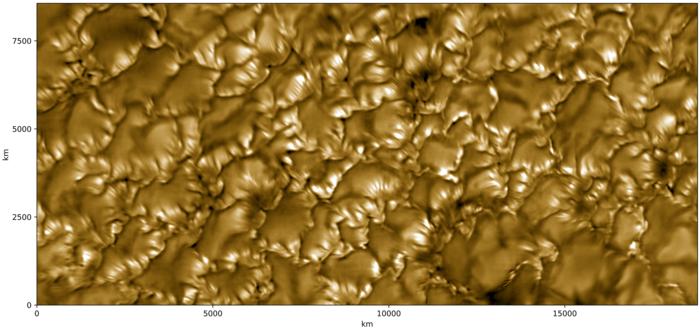
In an unprecedented achievement in solar astronomy, scientists have captured the sharpest-ever view of the Sun’s surface, unveiling ultra-fine magnetic “striations” that measure just 20 kilometers in width. This breakthrough was made possible by the Daniel K. Inouye Solar Telescope (DKIST), the world’s largest solar telescope, operated by the NSF National Solar Observatory on Maui. These striations, barely wider than the length of Manhattan Island, provide remarkable insight into the intimate dynamics of the solar photosphere and the complex magnetic fields sculpting it.
The Sun’s surface, or photosphere, is a roiling expanse of superheated plasma exhibiting a pattern of convection cells called granules. Until now, the subtle magnetic structures influencing this boiling surface remained largely unresolved, hidden beneath the limits of observational technology. Using DKIST’s Visible Broadband Imager (VBI) operating in the G-band—a spectral region optimized to highlight magnetic activity—researchers captured images with an unprecedented spatial resolution better than 0.03 arcseconds, equivalent to discerning details as small as 20 kilometers on the Sun’s surface. This represents a quantum leap in solar imaging resolution, allowing direct comparison with high-fidelity magnetohydrodynamic simulations.
The newly detected striations manifest as alternating bright and dark lines along the edges of solar granules. These patterns arise from “curtains” or sheets of magnetic field lines that ripple and shift, reminiscent of fabric blown by the wind. Light emitted by the hot plasma walls of granules passes through these magnetic curtains, where variations in magnetic field strength alter plasma density and opacity. Regions where the magnetic field is relatively stronger appear brighter, while comparatively weaker magnetic fields create darker striations. This interplay reveals fine-scale magnetic fluctuations on the order of only a hundred gauss—comparable to the magnetic field strength of a typical refrigerator magnet.
.adsslot_pZnOcsFKwW{width:728px !important;height:90px !important;}
@media(max-width:1199px){ .adsslot_pZnOcsFKwW{width:468px !important;height:60px !important;}
}
@media(max-width:767px){ .adsslot_pZnOcsFKwW{width:320px !important;height:50px !important;}
}
ADVERTISEMENT
The discovery sheds new light on the fundamental physics governing solar magnetism. As Dr. David Kuridze, lead author and NSO scientist, explains, “these striations are the fingerprints of fine-scale magnetic field variations.” By resolving features at such fine scales, astronomers can now trace how these small magnetic structures influence larger solar phenomena, including solar flares and coronal mass ejections that drive space weather impacting Earth. This high-resolution view bridges a longstanding gap between theory, simulation, and observation.
Achieving this feat required the unparalleled capabilities of the Inouye Solar Telescope’s 4-meter primary mirror, the largest ever built for solar observation. The telescope’s massive aperture allows light collection and focusing at exquisite resolution, capturing the delicate ribbon-like magnetic structures with clarity never before possible. The VBI’s G-band observations isolate regions of strong magnetic activity, enabling this fine-scale dissection of photospheric magnetism. Such detail was previously unreachable with instruments limited by atmospheric distortion or insufficient aperture size.
The team’s observations also confirm subtle Wilson depressions—minute dips in the solar photosphere caused by localized magnetic pressure changes that shift the visible solar surface inward by a few kilometers. These depressions were theorized but difficult to detect directly until now. The ability to quantify such small-scale morphological shifts provides an important new dimension to understanding the Sun’s magnetic topology and its dynamic behavior on minute scales.
Moreover, the implications of this research extend beyond solar physics. Magnetically induced striped patterns similar to these striations have been observed in more distant astrophysical environments, such as molecular clouds where star formation takes place. The capability to resolve and characterize these magneto-optical effects on the Sun offers an analog for studying complex magnetic structures throughout the universe, enriching our understanding of magnetic phenomena on multiple cosmic scales.
Continuous advancements in solar research instrumentation are vital as solar magnetic activity directly impacts space weather, which influences satellite operations, GPS systems, power grids, and communications infrastructure here on Earth. By probing the fundamental magnetic building blocks of the solar surface, this work improves predictive models for solar eruptions and helps mitigate the effects of damaging space weather events on technology-dependent society.
The collaborative nature of this research highlights the synergy between observational power and sophisticated numerical simulations. The study’s high-resolution images were compared against cutting-edge magnetohydrodynamic simulations that accurately replicate the Sun’s complex plasma physics under the influence of magnetic forces. This integrated approach confirms the physical reality of the striations and robustly elucidates their origin, morphology, and evolution.
This milestone was acknowledged by Dr. David Boboltz, NSO Associate Director for the DKIST, who emphasized the telescope’s pivotal role in pushing the frontiers of solar science. “It underscores Inouye’s vital role in unraveling the small-scale physics that drive space weather events impacting our increasingly technological society,” he stated. The telescope’s contributions continue to revolutionize our understanding of stellar surface phenomena with stunning visual evidence of magnetic interactions resolved at scales previously deemed unobservable from Earth.
Published in The Astrophysical Journal Letters on May 20, 2025, the paper titled “The striated solar photosphere observed at 0.03’’ resolution” presents these groundbreaking findings to the wider scientific community. The study catalyzes a new era in solar physics, inspiring future research to further explore the Sun’s magnetic complexity—down to a mere few kilometers—and its cascading effects on the heliosphere.
As observational techniques and computational models continue to evolve hand-in-hand, further surprises and insights into the Sun’s multifaceted magnetic character are imminent. This breakthrough paves the way for comprehensive exploration of solar magnetic fine structures and their critical influence on solar activity cycles, space weather forecasting, and astrophysical magnetism more broadly.
In summary, the Inouye Solar Telescope has revealed a previously unseen magnetic architecture on the Sun’s surface—faint, curtain-like striations that encode the dynamic interplay of magnetic fields at remarkably small spatial scales. These observations enrich astrophysical knowledge and bolster humanity’s capacity to anticipate and respond to the Sun’s often unpredictable behavior.
Subject of Research: Solar surface magnetic structures and fine-scale photospheric dynamics
Article Title: The striated solar photosphere observed at 0.03’’ resolution
News Publication Date: June 3, 2025
Web References:
DOI link to the paper
References:
Kuridze, D., et al. (2025). The striated solar photosphere observed at 0.03’’ resolution. The Astrophysical Journal Letters. DOI: 10.3847/2041-8213/add470
Image Credits: NSF/NSO/AURA
Keywords
Solar physics, Sun, solar magnetism, photosphere, solar surface, magnetic fields, striations, solar convection, space weather, astrophysics, Inouye Solar Telescope, solar observations
Tags: Daniel K. Inouye Solar Telescopehigh-resolution solar surface imagingmagnetic fields on the Sunmagnetohydrodynamic simulations of the SunNSF Inouye Solar Telescopeobserving solar magnetic activitysolar astronomy breakthroughssolar granules and convection cellssolar imaging resolution advancementssolar photosphere dynamicsultra-fine magnetic striationsVisible Broadband Imager DKIST






